
views
Understanding the Staff
Learn the basic parts of the bass clef. Staff: This is the collection of five lines and four spaces that music is written on. Notes can go above and below the staff as well. Each line and space matches a specific note. Ledger Lines: Lines above or below the staff that are added to expand the staff. Remember, however, that they all must have spaces between them as well, which indicate notes. Bass Clef: This is the backward "C" on the left-hand side of the staff. The two dots behind the "backward C" circles the second highest line of the staff, and that note should be F (the closest F below middle C on the piano) The bass clef is also known as the F clef, precisely for the reason that it helps mark the F note on the staff. Because of this, it can help to visualize the bass clef as the letter F—the vertical line in the letter is curved and the 2 horizontal strokes become the dots (which mark the location of the F).
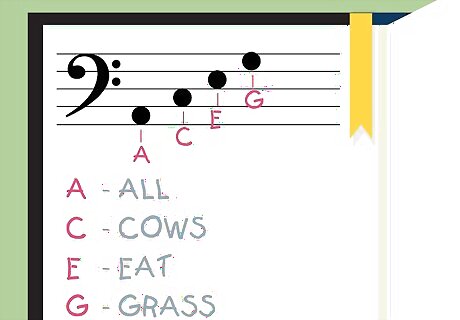
Remember "All Cows Eat Grass" to memorize the notes in the spaces from the bottom up. The lowest space (the one between the bottom line and the second lowest line) represents an A. The space above it represents a C, then an E, then a G. Thus, the notes in the spaces, form the bottom up, can be remembered: ------- Grass ------- Eat ------- Cows ------- All -------
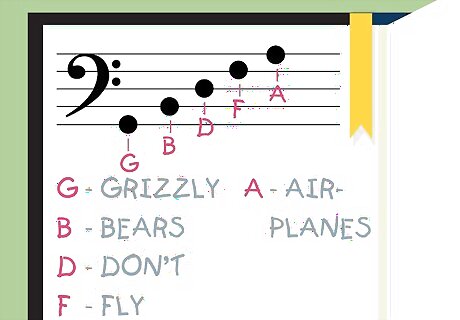
Remember "Grizzly Bears Don't Fly Airplanes" to memorize the notes on each line from the bottom up. The very lowest line is a G, then a B, then a D, F, and finally A. You can make up any mnemonic you'd like, but the classic is always easy to keep in mind: ---Airplanes--- _________ ---Fly---- _________ ---Don't---- _________ ---Bears---- _________ ---Grizzly----

Try out a few different mnemonics if you don't like the ones provided. Don't worry if you hate thinking about bears or cows. There are a variety of other mnemonics available, and you could even invent your own if you wanted. Remember that all of these count from the bottom up, because the notes go from lowest to highest. Spaces: Ants Can Eat Grapes American Composers Envy Gershwin Lines: Great Beagles Dig For Artwork Good Bikes Don't Fall Apart Garbage Bags Do Fly Away. Expand musical knowledge beyond treble clef. "As an amateur pianist only familiar with the treble clef mnemonics, learning bass clef seemed daunting. This article's funny memorization phrases like "All Cows Eat Grass" stuck in my mind perfectly. Now I can read both clefs thanks to these clever tricks." - Hope S. Adapt piano works for other instruments. "I'm translating Scarlatti piano pieces to classical guitar, which requires reading the unfamiliar bass clef. The tips here on relating treble and bass clefs helped me leverage what I already knew. With these mnemonics boosting my skills, I'm ready to conquer tricky transcriptions." - Ern P. Restart musical journey after years away. "As a 70-year-old who played piano as a child, I wanted to pick it back up but struggled with bass clef. The step-by-step approach in this article made the staff layout click — I finally understand the note positions. I can now relearn piano from the ground up thanks to these beginner-friendly instructions." - Linda H. Quickly comprehend beginner music concepts. "Starting piano lessons in my late 30s, I found basic music theory confusing. This article presented bass clef reading in clear, memorable ways perfect for a true novice. The mnemonic phrases and alphabet tip cemented my grasp of this new skill, boosting my musical confidence." - Andy R. Have a story our readers should hear? Share it with 1 billion+ annual wikiHow users. Tell us your story here.

Count through the alphabet, starting with G on the bottom line, to figure out the notes above and below the staff. The bass clef simply moves through the alphabet, with each line and space representing one "move." So, since the bottom line is a G, the space above it is an A. The line above that space is a B. The next space is a C, and so on, until you get back to another A on the top line. This will also help you with the lines above and below the staff. Simply work through the alphabet, counting each space and line equally: Your middle C is on the first ledger line above the staff. The space beneath it is a B. The space right below the staff is an F, and the first ledger line beneath it is an E. EXPERT TIP Cuong Nguyen Cuong Nguyen Music Teacher Cuong Nguyen is a Music Teacher and the Co-Owner of both OC Musica and the Huntington Beach School of Music. He has been teaching music for over 45 years and has extensive knowledge in music teaching pedagogy. He and his team of over 20 professional instructors specialize in teaching piano, voice, guitar, violin, brass, and woodwind instruments. Cuong is the 1984 winner of the Yoshiro Irino Memorial Prize in Composition. He received his Bachelor of Music with Honors from the Victoria University of Wellington, New Zealand. Cuong Nguyen Cuong Nguyen Music Teacher Relate bass to treble clefs. The bass clef can seem confusing at first, but think of it as the treble clef moved down the staff. If you know the treble clef well, use that knowledge as your starting point for the bass clef. This makes it way more intuitive to learn. Build on what you already know.
Improving your Reading Speed

Test yourself with "music reading quizzes," which require you to pick the note as quickly as possible. The best way to get good is to practice, and the best practice is reading notes as quickly as you can. There are many online quizzes for free, but you can also print out a collection of notes on a bass clef (or have a friend or teacher write one) and practice identifying each one perfectly. As you get better, time yourself on each quiz. Work on improving your accuracy along with your speed -- don't sacrifice quality for speed until you can get each note without mistakes.

Hit the matching note on your instrument as you read each note. Print out or write down a staff with a random collection of notes. As you identify each one, play the same note on your instrument. This will train your brain to not only identify the note but the sound and the physical positioning of each part of the staff. You'll improve your playing speed considerably as a result.
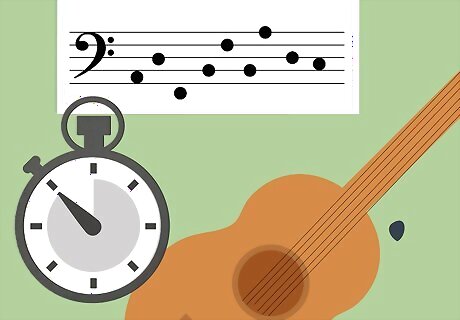
Practice with written music each time you practice. If you want to work on reading music, in any clef, read music and play. Even if you mostly improvise, work on scales, or don't use written music, you should still devote 10-20 minutes to reading music and playing along.
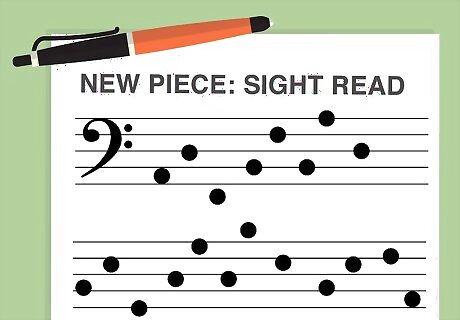
Try sight-reading to warm-up and work on your bass clef skills. Sight-reading is when you put a brand new piece of sheet music in front of you and play it as you read for the first time. It isn't easy, but it is one of the best ways to get speedy on the staff. Again, make sure you don't sacrifice quality for speed. Play it at half time if you're continuously missing notes or have to stop and start. Remember -- this is practice, not a performance.



















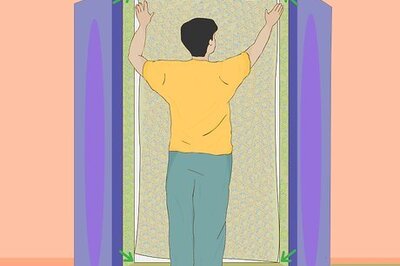
Comments
0 comment